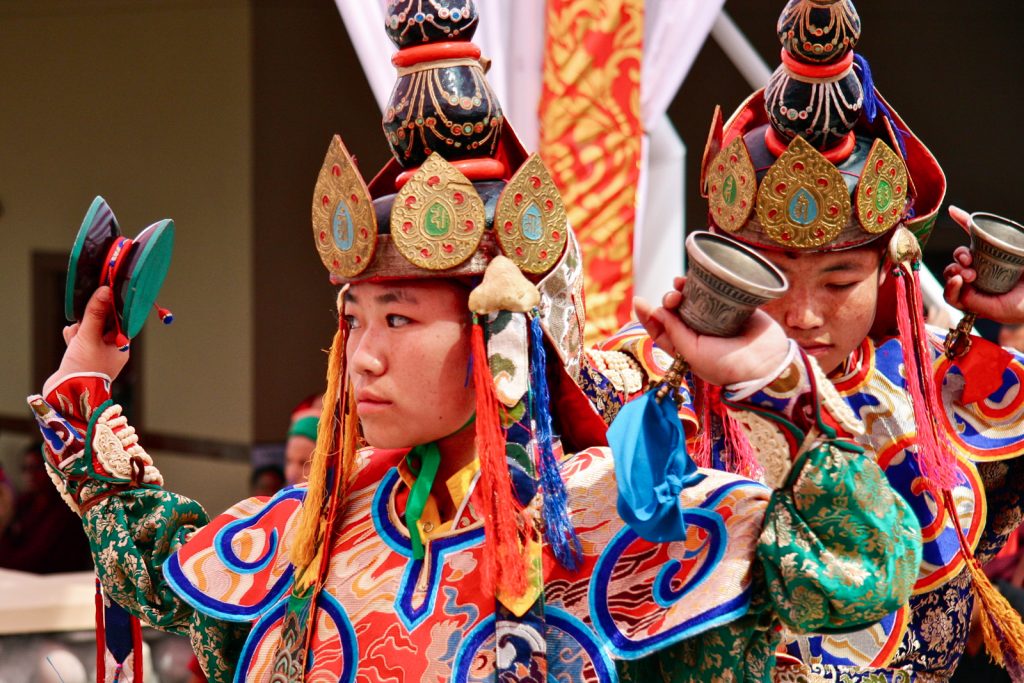The nuns of Dongyu Gatsal Ling Nunnery (DGL) in the northern Indian state of Himachal Pradesh have instituted a new tradition: dakini dance. This practice actually dates back to the beginnings of Vajrayana when ritual dance was performed by both female and male participants (as later described in the 8th century text the Hevajra-tantra). But as Buddhism went on to be practiced and promulgated in the monasteries of Tibet and the Himalayas, the public performance of sacred dance (Tib., cham) became the purview of male practitioners─until recently. Under the leadership of renowned nun Jetsunma Tenzin Palmo, these female practitioners have been reclaiming their right to fully participate in all aspects of Himalayan Buddhist tradition, and providing a positive model for more equitable and dynamic Buddhist communities.
Dakini (Tib., khandroma) is often translated as “skydancer” or “she who moves through the sky” and refers to a feminine energy being who facilitates, or even instigates, one’s spiritual progress. Judith Simmer-Brown, in her book Dakini’s Warm Breath, discusses how the dakini, in Buddhist tantra, were elevated beyond particular beings into a greater principle where the feminine represents wisdom itself. Here, wisdom is interpreted as insight into emptiness, or the abiding awareness of the inter-relativity and impermanence of all phenomena. The dakini, frequently portrayed iconographically as dancing, moves with ease in the boundless space of emptiness. Indeed, dancing metaphors pervade Buddhist archetypes of enlightenment in both art and text because they demonstrate ideals such as dynamism, fluidity, stability, fierce energy, and equipoise.
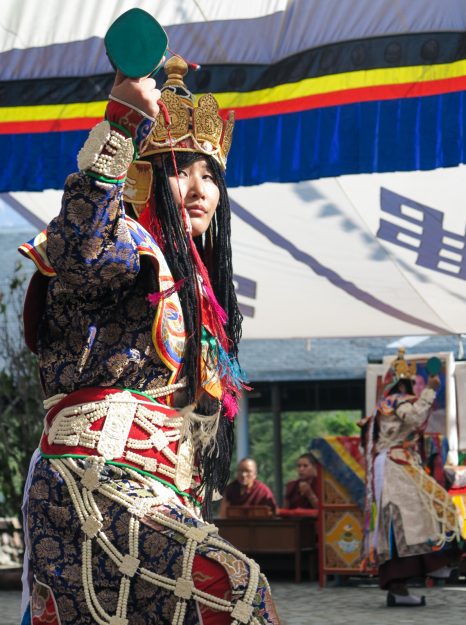
Dakini dances, like all cham, are embodiments of divine activity and Buddhist teachings. They are often performed while generating a visualization of a Buddha field, or field of spiritual support—which would include buddhas, bodhisattvas, lineage ancestors, teachers, meditation deities, dakinis, dakas (“spiritual warriors”), and dharma protectors—within the framework of a larger ritual.
The dances are performed in colorful brocade gowns decorated with elaborate bone ornaments─belt, apron, necklaces, bracelets, earrings─and topped with a golden five-lobed crown. These accessories are worn to stimulate the six paramitas, or perfections. The necklace is worn to rouse generosity. The armlets and bracelets encourage ethics, the earrings instill patience, the head ornaments stir joyful effort, the belt and apron promote concentration, and the female practitioner’s body symbolizes wisdom. The dancers vibrate a double-headed damaru drum with the right hand to represent compassion, and ring the drilbu (“bell”) with the left to signify emptiness. They sound these instruments with each step of the dance as a display of these two equalities of enlightened awareness.
Because tantric practitioners traditionally practiced in cremation grounds and repurposed the remains encountered there into ritual implements, skulls were often used to make the damaru drums, and ritual skull cups and small bones were transformed into delicate ornaments to be worn. These elements of the dakini costume are reminders of how the practitioner confronts places and experiences that scare us, such as death, but can use these encounters for spiritual practice.
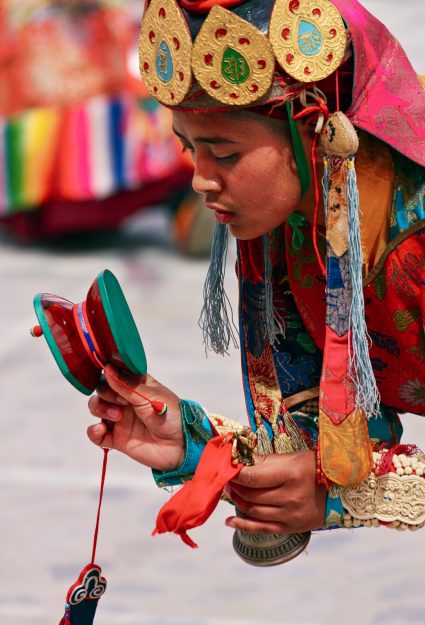
Back in 2003, the nuns of Druk Amitabha Mountain nunnery in Kathmandu, Nepal, were empowered to dance cham by the head of their lineage, His Holiness the Gyalwang Drukpa, and their practice has grown and flourished ever since.
Having seen the Druk Amitabha Mountain nuns performing these dakini dances, Jetsunma Tenzin Palmo in 2013 asked to send a group of five senior nuns from her nunnery to Druk Amitabha to learn the dances. (Jetsunma is also instituting another tradition at DGL: that of the female lineage of Togdenma yogini meditators, a tradition lost due to the communist takeover of Tibet.) The Gyalwang Drukpa not only agreed to Jetsunma’s request, but also subsidized the nuns’ journey and gifted them ten dakini costumes, complete with ornaments.
The DGL nuns first performed the dances in public for the inauguration of their temple in 2014. According to Jetsunma, “At that time about 1,000 people came, including all our Rinpoches, monks, and lay people from Tashi Jong, [a nearby community]. The lamas and monks were deeply impressed with the nuns’ performance. Later they danced at various events, including the inauguration of the temple of Choegon Rinpoche, which also included a large audience.” Noting that the nuns could not rely on such special events to keep the dances well-rehearsed, Jetsunma suggested that the dances become an annual part of DGL’s Lhabab Duchen celebration. This major holy day commemorates the Buddha’s return to Earth from his three-month sojourn in heaven to impart the dharma to his mother and other celestial beings─a perfect occasion to perform these dances, which are sacred expressions of the enlightened feminine.
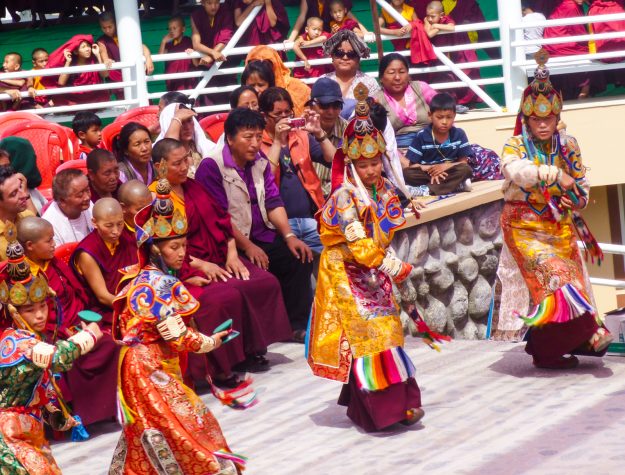
For Lhabab Duchen last year, the DGL nuns began the morning festivities with Khandro Denga, the Dance of Five Dakinis. The dance is also called Khandro Tenzhug, or Long-life Prayer to the Dakinis, and is usually performed as part of longevity rituals meant to remove obstacles to the long lives of the great lamas, spiritual teachers, and all beings. In Himalayan Buddhism, prayers requesting that a spiritual teacher remain in this world are frequently composed and recited because the teacher’s longevity is considered practitioners’ best opportunity for enlightenment. The tradition holds that the dakinis and other celestial beings, meanwhile, desire these great teachers to move on to other buddha realms and summon them to leave this life. The tenzhug (“long-life”) ritual and accompanying dance are performed to avert the call of the dakinis, or as one such prayer proclaims, “Gather back the silken beckoning cord of the viras [‘heroes’] and dakinis.”
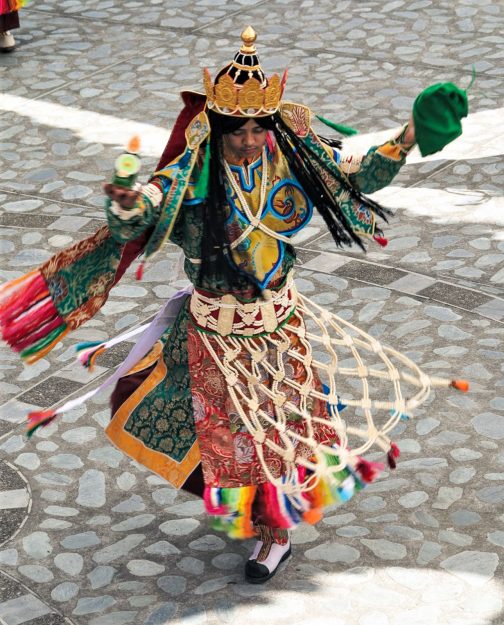
The dance begins with five dancers entering the dance ground to the blasts of long horns while they energetically skip, leap, and turn. They continue the movements after having formed a circle; the circle eventually unfolds into a wide row (usually facing the lama or beneficiary of the prayer). The dancers represent the five wisdom dakinis from the five buddha families and the corresponding aspects of enlightened mind: buddha (spacious), ratna (enriching), vajra (indestructible), padma (magnetizing), karma (accomplishing). Each dakini is identified by costume and ritual attributes in the color of her buddha family─white, gold, red, green, and blue─which are associated with the five natural elements.
From the row of dakinis, one steps forward and dances, presenting a torma (a butter cake offering) and ceremonial khata (“scarf”) to the celestial dakini being invoked in the prayer. She holds them in her outstretched hands as gifts to ensure the long life of the lama. Her movements are echoed by the other dancers behind her. Having made her offering, the featured dakini dances away and kneels to the invoked dakini, the lama, and the assembly—both envisioned and embodied—before exiting amidst prayers requesting the removal of obstacles to long life. Afterward, the next dakini begins her offering dance. The dance is complete once the last dakini exits and the prayers are finished.
The nuns went on to perform Rigma Chudruk Cham, or Dance of Sixteen Goddesses, at the Lhabab Duchen ceremony. In this dance, sixteen dakinis enter with a swirl of energy to the blasts of the horns, much like the earlier dance, and form a circle. They move around the circle, hopping and turning, their arms spiraling overhead with the rattle and ring of the damaru and drilbu. The instrumental accompaniment stops, and the nuns chant another long-life prayer while continuing to dance. Moving around the circle, they hinge their torsos forward, hopping on one leg with the other extended forward, while sounding the damaru and drilbu.
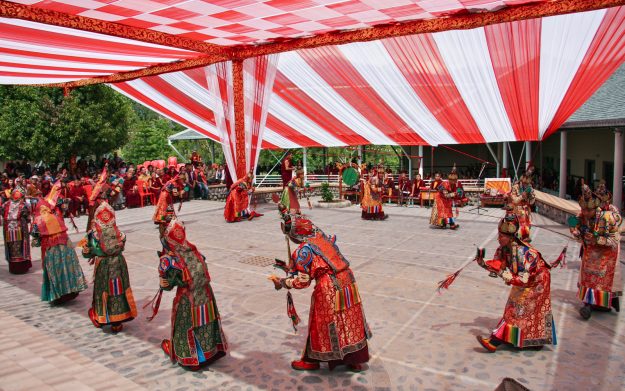
Then, standing in place and facing the center, they vibrate their instruments upward to the right and left, around in circles several times, and downward to the left and right. The dancers raise one arm and hop a revolution in one direction and then turn, reversing the direction. Once the hymn is completed the cymbals and horns assume the accompaniment and the dancers move toward the center, pressing the hand with the bell forward before turning to move back outward, pressing with the hand holding the damaru.
As this year’s Lhabab Duchen approaches, the DGL nuns are currently rehearsing the dakini dances and more young ones are learning them. They are also preparing plays and comedy skits, which everyone will enjoy during the festive picnic. Meanwhile, despite the continuing lockdown, the nuns carry on much as usual with their studies (philosophy, debate, classical Tibetan, prayer and ritual, English, computer skills), ritual practices, physical yoga, nunnery chores, and now gardening. Their regimen is punctuated with academic exams, Buddhist festivals, and an annual two-month rainy day retreat (where even the little ones maintain their silence). Jetsunma has also embraced the experience of Zoom sessions with dharma groups from around the world, and the nunnery plans to livestream this year’s Lhabab Duchen dances on Jetsuma’s Facebook page. The holy day will conclude with evening puja (prayer service), followed by animated debating under the decorative fairy lights, which are currently being hung to festoon the DGL temple.
When the original five DGL nuns traveled to Druk Amitabha, they were given a formal meeting with the Gyalwang Drukpa, who asked them to demonstrate their competence by performing the dances for him and their nun instructors. Though everyone was pleased with the results, the nuns later admitted to feeling nervous. They have since taught the dakini dances to some forty or fifty nuns—and counting. In this way, one spark lights a fire and centuries-old restrictions to female capability and practice gradually become obsolete.
♦
Watch this year’s Lhabab Duchen dances on Jetsunma Tenzin Palmo’s Facebook page on October 26.
Thank you to Jetsunma Tenzin Palmo of Dongyu Gatsal Ling and Lopon Jigme Tingdzin of Druk Amitabha Mountain for generously providing explanations and visual media.
Thank you for subscribing to Tricycle! As a nonprofit, we depend on readers like you to keep Buddhist teachings and practices widely available.
